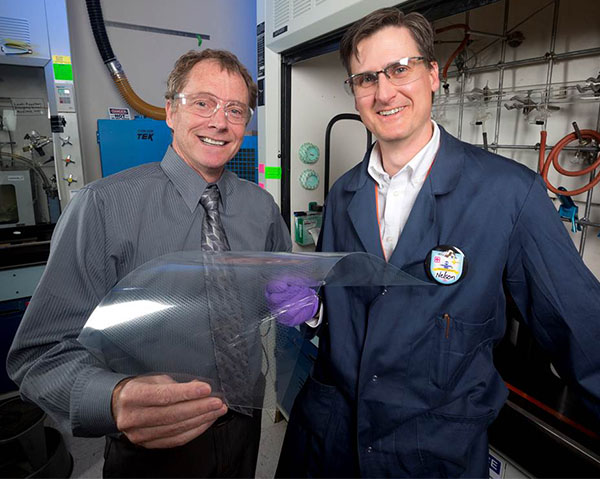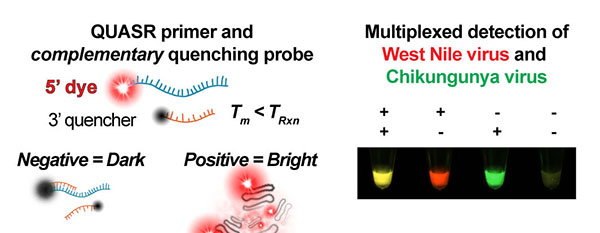Sandia CRADA boom sets records, forges ties

Sandia entered into a vast array of new Cooperative Research and Development Agreements (CRADA) between fiscal years 2013 and 2015, bringing dozens of new partners to the Labs.
“This is a great mechanism for getting Sandia technology into the private sector,” says CRADA specialist Jason Martinez (10575). “We develop cutting-edge technology and capabilities with underlying science that is phenomenal. The CRADA is a vehicle to take that work and benefit the US economy.”
A CRADA is an agreement between a government agency and a private company or university — or at least one non-federal entity — to work together on research and development. Sandia signed 133 CRADAs during the past three fiscal years; 82 were new and 51 were amendments adding tasks or funding to existing agreements. The actual contract value to Sandia, which includes in-kind and government dollars, was more than $105 million.
Sandia has active CRADAs with 65 partners ranging from small businesses to nonprofits to industry giants. The Labs recently executed one with a university for the first time in 15 years.
“FY 13, 14, and 15 were all record years for CRADAs, and FY16 is on track to be another one, in numbers and in value,” Jason says. “It could be significant.” About 15 have been signed so far in FY16, one with the second-largest value on initial execution in Labs history.
Andy McIlroy, director of Research Strategy & Partnerships Dept. 1900 and deputy chief technology officer, says CRADAs serve Sandia’s national security mission by broadening the impact of the Labs’ work through interactions with companies and other entities. “The partnerships also enrich the Labs with more perspectives,” he says.
A cornucopia of companies
There has been no single reason for the boom, Jason says. “It’s like farming. Sometimes there’s a bumper crop that you can’t attribute to one particular thing like the soil or the weather,” he says. “There is a cornucopia of companies and organizations that want to work with us. We’ve seen a bumper crop of CRADAs.”
A standard CRADA covers a single project in one technical area in a fixed amount of time, and an umbrella covers multiple projects and technologies over a span of time. “An umbrella is more strategic, offering the dynamic ability to place different project and task statements in different areas,” Jason says. “One of our partners has more than 100 project and task statements over different organizations and PMUs.”
The agreements are funded a variety of ways: A company pays to work with Sandia; the partners use DOE work authorization funds allocated to the Labs; or the funding comes from another federal agency or Laboratory Directed Research and Development, both of which fall into the in-kind category. CRADA contract values range from $50,000 to multimillions.
Training and awareness
One reason for the boom is that Sandia’s CRADA department has been proactive, meeting with and training numerous technical groups at the Labs on the process and the opportunities. Training materials have been developed and the steps to doing a CRADA have been simplified. “We’re meeting with pretty much every technical line manager at the Laboratories to augment awareness and let people know this can be a vehicle to supplement finite resources,” Jason says. “The word is getting out internally and externally. We’re making it easier on both sides.”
Sandia created an external website devoted to CRADAs. “Someone who has never heard of a Federally Funded Research and Development Center or a CRADA can visit and ascertain what the steps are,” Jason says.
Members of the technical staff can seek industrial or university partners through ads on FedBizOpps, the database of federal government contracting opportunities, placed by the CRADA department. The ads also will appear on the Sandia CRADA website.
“CRADA partners benefit from 70 years and billions of dollars of taxpayer-funded research,” Jason says. “Sandia’s research can benefit the economy in important and impactful ways. It gives the CRADA partner the seed to commercialize a technology and develop a competitive advantage within their industry.”
Small is big
Sandia has Cooperative Research and Development Agreements (CRADA) with a variety of small companies. “There is a misperception that CRADAs are only for the big players,” says CRADA specialist Jason Martinez (10575). “We have a very active portfolio with small companies.”
Here are a few:
- EyeTracking Inc.: Sandia is working with EyeTracking to produce algorithms, software, user interaction models, and user interfaces to advance state-of-the-art eye-movement data collection and analysis. Sandia’s research into human visual cognition with dynamic stimuli parallels the San Diego company’s recent advances in the analysis of complex interaction patterns. The CRADA will advance the collection and analysis of human visual perception and cognition with dynamic content.
- IR Dynamics LLC: The Santa Fe company and Sandia’s Electronic, Optical, and Nano Materials Center are developing thermochromic materials for control of infrared transmission. They could be used as pigment additives for smart windows or pigment-based coatings in architecture, transportation, and clothing.
- Red & White Fleet: Sandia and Red & White Fleet of San Francisco are doing a feasibility study on the design, construction, and operation of a multi-use, high-speed hydrogen fuel cell passenger boat and high-capacity multi-use hydrogen fueling station. The project aims to reduce maritime emissions to near zero, help develop and refine maritime hydrogen codes, and create a competitive alternative to current diesel boats. If the study shows a path forward, Sandia and Red & White Fleet will continue to collaborate.

QUASR improves the signal obtained from the traditional DNA amplification technique known as LAMP, which can be coupled with a reverse transcriptase to amplify RNA targets. QUASR attaches a dye to a LAMP primer of interest, causing amplified DNA to fluoresce brightly enough to be read by the human eye. A complementary quench probe attaches to any unincorporated primer after the reaction cools, making negative reactions dark. The difference between positive and negative reactions is unambiguous enough to enable simultaneous detection of multiple viruses.
RT-LAMP relies on primers, DNA fragment sequences, that bind to a target — the RNA of the virus of interest — and then generate a large amount of DNA. By fluorescently labeling the primer, the new DNA glows as it is produced. If the primer doesn’t find the viral RNA, there is no glow.
The Sandia researchers added a different DNA fragment sequence called a quench probe that complements a short stretch of primer. As the reaction takes place, the quench probe suppresses any unincorporated primer. This amplifies the positive signal up to 10 times brighter than a negative signal. Because the signal is so bright, QUASR can screen up to three different targets simultaneously, saving time and money.
“We didn’t expect a signal that bright, so we came up with the name QUASR, inspired by quasars, the extremely luminous celestial objects that can be a trillion times brighter than the sun,” Robert says.
QUASR is simple enough to be used in a field laboratory. The Sandia team is working to incorporate QUASR into a handheld device.
Vector-control districts stand to benefit greatly from QUASR. Such districts are typically the units of public health agencies that monitor and control disease-carrying insects locally.
QUASR enables rapid response
Currently, detecting disease-carrying mosquitoes is a complex and lengthy process. A field worker in a vector control district collects and prepares mosquito samples, which are then sent to a lab for testing using sophisticated PCR techniques.
Using QUASR, either in a portable microfluidic device or simple field laboratory, a user can get a definitive yes or no result in about half an hour. More details like the amount of viral RNA present in the sample would still require laboratory PCR.
“This would allow those in the field to make quick decisions on mosquito abatement that can prevent the spread of disease,” Robert says.
QUASR also can be adapted to screen people for diseases such as the Zika virus or Ebola virus. This is a constantly changing landscape; a year ago, few people had even heard of Zika virus, which the World Health Organization recently declared an international health emergency.
“Conceptually, it’s not difficult to adapt the assay for a different virus,” says Robert. “There is some trial and error involved in refinement as you are dealing with a different virus and human sample.”
Robert recently received a National Institutes of Health (NIH) grant to develop a field-deployable assay for differential diagnosis of malaria and viral febrile illnesses including Ebola. The University of Texas Medical Branch at Galveston is a partner in the grant.
Because malaria and Ebola have similar symptoms — fever, chills, headache, diarrhea, and vomiting — health officials worry that patients with malaria are being sent to Ebola quarantine wards.
“A point-of-care device that can quickly discriminate Ebola from malaria in a blood sample would prevent dangerous misdiagnoses,” says Robert.
Lassa, dengue, and other febrile illnesses are also targets for the NIH project.
A bright future
Robert and his team set out to tackle the problem of false positives. “Even a marginal false positive rate would defeat the purpose of an autonomous monitoring device,” he says. “The signal amplification, the amazing brightness of the positive response, was not a goal but certainly a welcome result.”
While the human eye can only effectively discriminate three distinct colors, the team is developing imaging technology that could enable simultaneous screening of even more targets.
“I’m very excited about what this technique can do for field workers,” Robert says. “The ability to make fast decisions about where to direct mosquito abatement resources or how to triage patients will help us stay ahead of mosquito-borne disease outbreaks.”
The work was funded by Sandia’s Laboratory Directed Research & Development program.